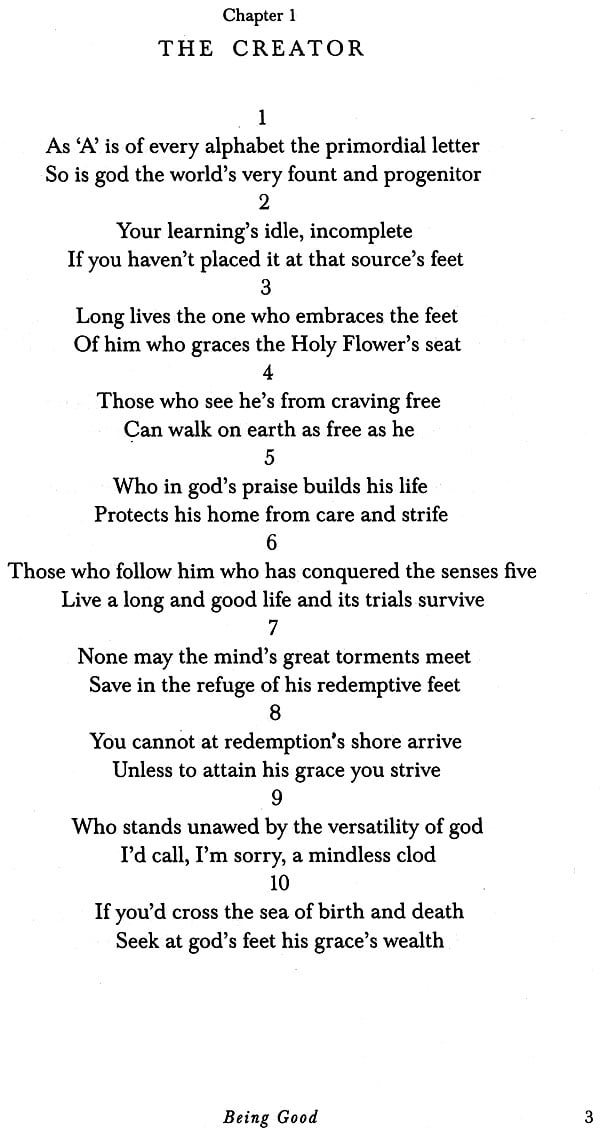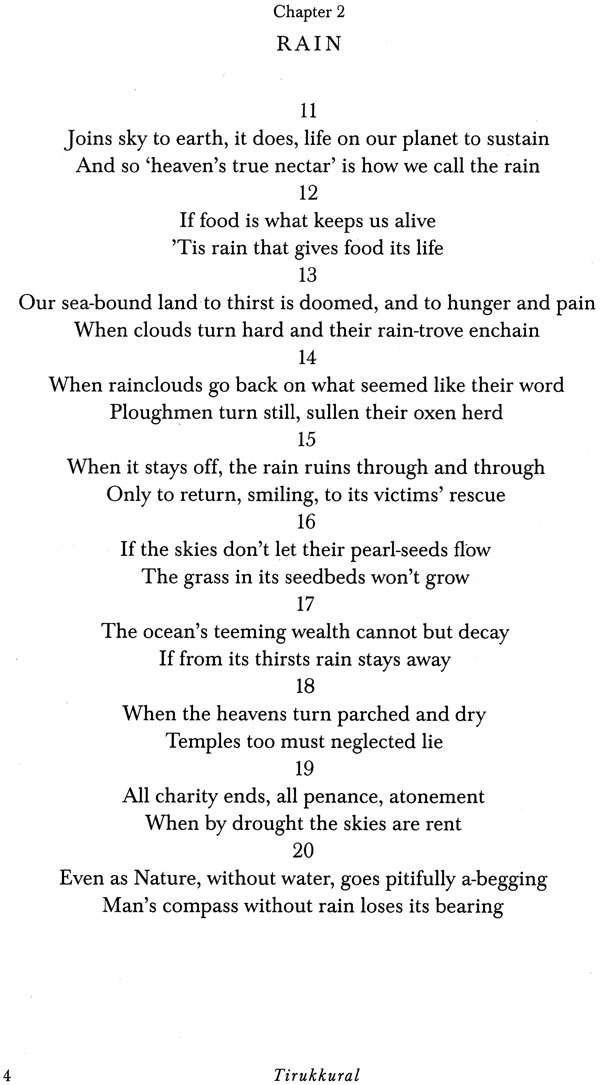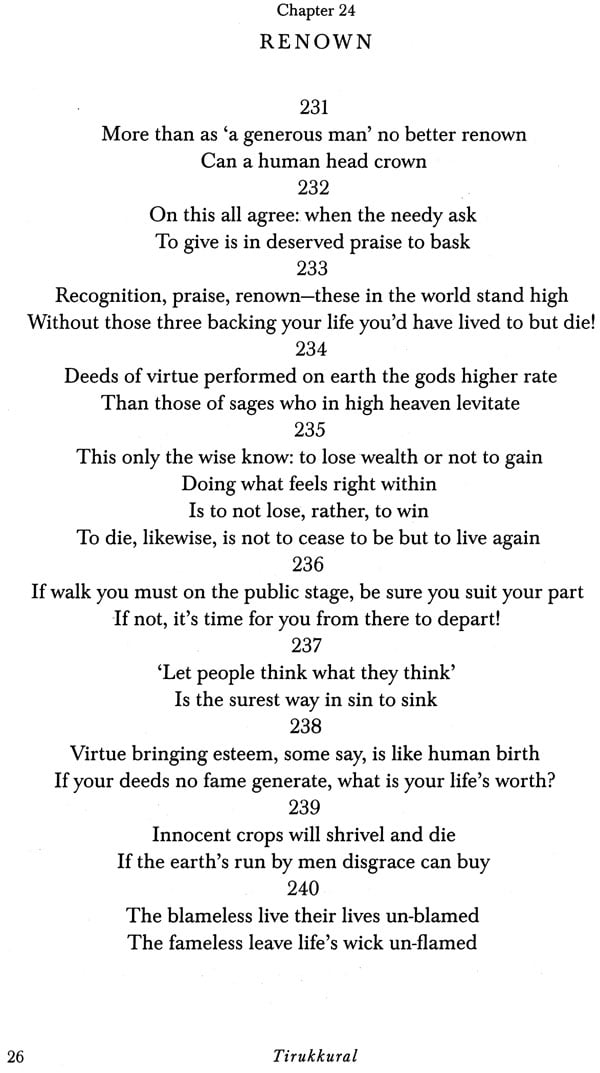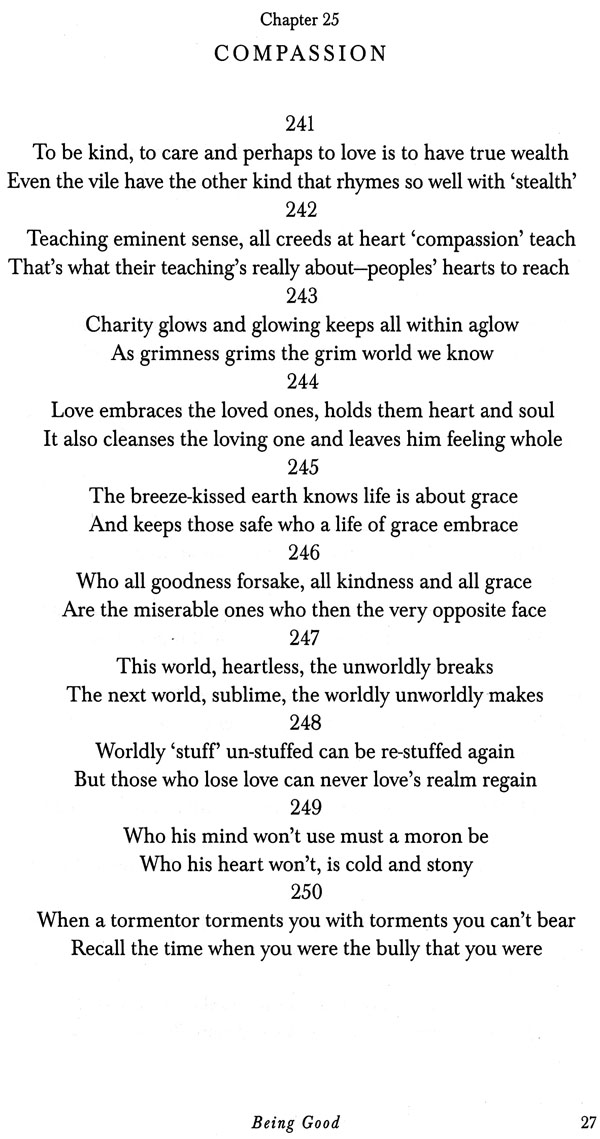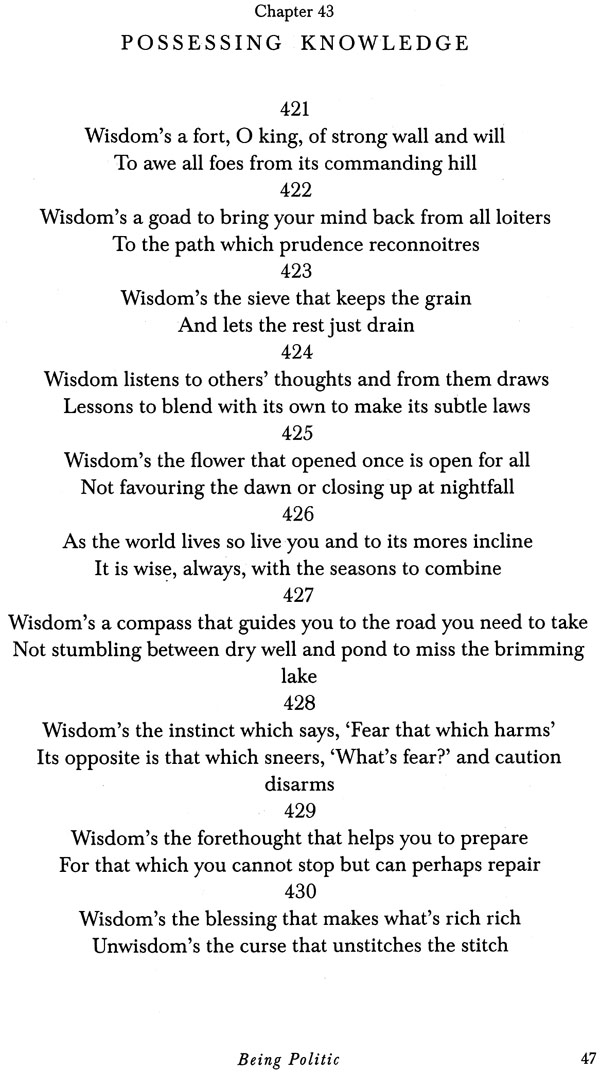
The Tirukkural
Book Specification
| Item Code: | NAP606 |
| Author: | Gopal Krishna Gandhi |
| Publisher: | Aleph Book Company |
| Language: | English |
| Edition: | 2015 |
| ISBN: | 9789383064700 |
| Pages: | 190 |
| Cover: | Hardcover |
| Other Details | 8.0 inch X 5.5 inch |
| Weight | 270 gm |
Book Description
The Tirukkural has been admired as literature, venerated as secular gospel, and translated times without number into the world's different languages. This new version recreates the beauty of Tiruvalluvar's masterpiece for the twenty –first –century reader.
As 'A' is of every alphabet the primordial letter so is god the world's very fount and progenitor
Life is life when lover and loved both live it together Loveless men are but –what shall I say bones clad in leather
Learner, learn your learninng full well and fault free and then make your learning with life's living truths agree.
The Tirukkural (honoured Kural) is one of the world's greatest literary and philosophical masterpieces. Composed in Tamil by Tiruvalluvar sometime between 2 Bce and 5 Ce, its succinet couples seek to explain and guide the reader through life's various situations: political, spiritual, domestic and social.
Not much is known about Tiruvalluvar –he is believed to have been one or more of the following: a weaver, an ascetice, a teacher, a minister, a seafarer or even a king. What is indisputable, as Gopalkrishana Gandhi says in the preface, is that he was ' a clear thinker',' a sharp observer of life' and ' a master of his language and complex poetic forms.
Kural in Tamil, means 'short'. Each of the Tirukkural's 1330 verses holds its meaning tightly, gives its message in something like telegraphase. Often called the universal book of principles, the work is organised into 133 chapters and three books. Book I Being Good is aimed at householders and sets out the principles of leading an eithical life. Book II: Being Politic is manual for rulers and statesmen on the qualities and duties of leaders, aspects of governance, militarty strategies, and methods to aquire wealth honestly. Book III: Being in Love isa expostion on love. It is presented from the points of view of both the man and the women in different situations –from the moment of falling in love, through the pain of seperation to the joy of reconciliation.
Talking about our classics, the philospher and statesman Dr. S. Radhakrishanan said as they 'constitute the essential spirit of our culture, are a part of our very being they should receive changing expression according to the needs and conditions of [a particular] time. Gopalkrishna Gandhi's retelling of the Kural, in keeping with that philosphy, showcase the great beauty and wisdom of Tiruvalluwar's masterpiece for the twenty –first- century reader.
For the many who know the Tirukkural, this initial word about the book will be redundant. For those unfamilier with Tiruvalluvar's undimming work, a brief description of it might be useful. Both the author's name and that of the work are 'given', that is, they are not orignal names, for we do not know what he was actually called, and he did not title his work.
'Kural' in Tamil means 'short'. The 1,330 couplets that make up the Tirukkural are short, each making a compact, concise propsition. The first line, typically, has four words, the second has three. The syllabus per line can sometimes vary, but not the number of words or material feet. Together, they are like a cluster of seven gems, set in two rows. The Tirukkural –'the honoured Kural' –is traditionally dated to the immediate post Sangam period, reffering to the era of the Tamil academies (sangams) that are said to have flourished between 300 BCE and 300 CE. The Kural deploys the austerity of the Venba material feet (cir), alliteration (monai), second –letter alliteration (ethuhai) and rhythm (osai) like a master of cryptograms. Verbs are absent, nonus truant. This economy tightens the expression to that point beyond which tightenning would strangle meaning. The opening couplet offers a perfect sample:
The first word of each line of clicks into an internal rhyme + alteration with the correspondence of sounds occuring without variation in the second letter before the rythem flows into the third: A-kara/Bha-gava(n). Sanskrit has borrowed this as 'dvitakshara prasa' (alliteration in the second letter). 'Containing', in the words of the book's best –known translator, G.U. Pope, 'a complete and striking idea expressed in a refined meter', everyone of the 1,330 kurals is belived to be the work of a single author, Tiruvalluvar. Written sometime between 2 BCE and 5 CE, The Tirukural speaks within a frame, thinks without frontiers. It is presented in three Books. The first has traditionally been called the Book of Virtue, the second the Book of Wealth, the third the Book of Love. They deal with, respectively, righteous living, statecraft and conjugal love.
Tiruvalluvar was an exceptionally powerful thinker, a master of his language and its literature's complex poetic forms. He was a sharp observer of life. The Kunal is the result of his literary labours, a spectacular insight into the workings of the human brain and the waywardness of the human heart. Admired as literature, venerated as secular gospel, translated times without number into the world's different languages, the Tirukkural's teaching have yet been ignored by generation after generation of an unwise humanity.
When smitten by a book, readers want to become part of it, immerse themselves in the life of the volume they hold in their hands.
While the fever is on, they cannot part with the book. They keep it on their person, as W.B. Yeats did his copy of Tagore's Gitanjali. ' I have carried the manuscript of these translations about with me for days, reading it in railways trains, or on the top of omnibuses and in restaurents, and I have often had to close it lest some stranger would see how much it moved me.'
They of course talk about it as of a personal, even private, discovery to those close to them. some of them, if they think of themselves as writers, will try to find a journal that might carry their review of it. The most ambitious, evene audacious, way of finding a union with the work –for that is what the smitten want –is to try translating it and thereby enter the work's very soul.
'translator ambition' includes new translation in the same language and, in the case of fiction, screen versions and film scripts. Given in generosity, the permission is often regretted in hindsight. R.K Narayan recounts how his novel. The Guide, when it was made into a film became another being. The location, he was told, need not be where he had visualized it to be. 'Malgudi will be where we place it, in Kashmir, Rajasthan, Bombay, Delhi, even Ceylon.'
When he protested that a tiger fight scene would be wrong. For there was no such thing in the stroy, he assured that it was. He just gave up, in the spirit of the first line of a song in that film sung by Mohammed Rafi –'Kya se kya ho gaya!' meaning 'What have you gone and done!'
An author may dearly wish the go-ahead had not been given to a translator or to that mutilator calling himself 'transcreator', bemoan the translation's excesses and lament its shortfalls, but once the deed is done, the translator becomes, for all time, part of the work's aura.
Not all translations, of course, come about that way. Some are commissioned by the author or a publisher quite matter –of –factly for the benefit of readers belonging to another linguistic register. For the 'engaged' translator such exercise can be no less fulfilling –or self –fulfilling –than for the self –appointed one. This translation of Tiruvalluvar's 1,330 rhymed Tamil Valluvar exclaim from his post –earthly world: 'What have you gone and done!'
When David Davidar asked me if I would consider translating the Tirukkural into English, I was, to say the least, startled. Trying to imagine myself doing this, I said: 'I do speak the kind of "home Tamil" those descended from a Tamil household do, and the only Tamil reading I have done is of newspaper. And as for the Kural, I have read it only in Rajagopalachari's English Translation –that's all. Exactly for that reason, David went on to say, a new version in modern, accessible English was north placing in the hands of a new generation of readers, especially those not familieer with Tamil. 'In any case, between the rendering by Rajaji done in the 1930s and one that might be attempted eightly and more years later, several decades have passed.' And then, mining his own knowledge of the text, said: 'Many of us whose mother tongue is Tamil have known the couple: "Karka kasadara karpavai kattrapin / nirka adharku thatga" and have known it to mean, generally, "Learn whatever you learn throughly, without doubts or defects, and then apply the learning", but the saying needs to be refereshed now for our times'.
'let me,' I said, 'first take a close look at the text.' Rumination preceded reading. I recalled four occasions when the Kural was cited to me in the ordinary course of things. I was not yet twenty when I heard Rajagopalachari describe the speed of the assistance rushed by officers to flood victims in the Krishna and Godavari basins in 1954. He was cheif minister of undivided Madras at that time. 'How would you describe,' he asked me, 'the speed of help that comes the very moment it is needed?' 'The speed of light?'
'Yes but Tiruvalluvas has a better descritpion for that speed. He describes it in his great work that you must read one day, called the Kural, as the speed of the hand that moves the very instant a garment slips, to halt its fall...'
It was some years later that I read his rendering of the 788th kural in which, to hte description of slipping garment, he adds, typical of his conservatism, a context: 'slips in company'. Every translator adds somethings, be it ever so slight, to the original.
My second recollection is of 1969. I was an IAS Probationar in Tanjore when the young but unbelievably wise sub –collector of KUmbakonam, D. Murugaraj told me: 'The Gita is a great book, but the Kural, in my view, ranks higher. Whatever else you read as a trainee in Tamil Nadu, you have to read that masterpiece.'
A couple of years later, at the inauguration of a school near Gingee, where I was posted as an assistant collector, an MLA was was pontificating on the virtues of learning. 'Men of learning,' he quoted from the book, 'have eyes, blockheads have two sores.' The 393rd kural seemed to have been tailor –made for the men himself but I let my wicked thought pass.
My fourth induction into the Kural being invoked is from a decade later. Watching me entranced by my two little daughters' baby talk, my mother said, 'You know, the Kural says those who call the veena's sound or the taste of honey sweet have not heard their own little one's sweet lisps.' Her words came fluting into my mind as I now read the 66th kural. It was with these random recollection refereshed in my thoughts that I opened, for the first time in my life, the 1,330 kurals. I found that I just could not make out their meaning. It is an unusual experience to be able to read a script but not get the sense of what you are reading. Of each couplet –with four words or feet in the first line, three in the second –I could just about understand one or two. Five or six –the majority –of the words were completely beyond my comprehension. And this is where my obtaining the Rev. G.U. Pope 1886 English translation made all the difference. Rukmani Devi Arundale's collection of antiquarian books in Kalakshetra, Chennai, has a 1980 reprint of Pope's translation entitled The Sacred Kurral, giving the author's name as 'Tiruvalluva –Nayanar'. This particular reproduction by Asian Educational Services, New Delhi, is only thirty –five years old but has already browned into the feel of an old book. Its pages melt and come off when turned. Poring over them as ginerly as I could, I could see why Pope's English rendition of the Kural is regarded as definitive.
Pope has gone into the work like a conch fisher dives into the sea. He disappears into the Kural to emerge with a find that is form that point on 'his'. He gives us Valluvar that is his Valluvar, a kural that is his Kural and yet is unmistakely Valluvar's. Reading Pope's renderings, matching them with the Tamil verses and then dipping into Beshi's Latin equivalent (1730) and the rephrasings of F.W. Ellis, both of which Pope appends to his volume, was sheer exhilaration.
The Lexicon and Concordance given at the end of his work proved invaluable. In his translation, Pope gives us his understanding of the couplets; in the Lexicon and Concordance he gives us the word to word meaning as if saying 'Check my version out, word by word'. Going back and forth in this study, i knew I surprised. David Davidar knew the classic's timeless appeal. And before I quite realized it, I found my self becoming a 'commissioned translator' of the work and, exactly like the besotted reader, entering its deathless life.
I also returned, as I had to, to the much –thumbed copy of Bharatiya Vidya Bhavan's 1965 edition of Rajagopalacharya's translation and commentary in our home's peripatetic bookshelves. Half a century old, its binding had all but come apart. But on my picking it up now it 'held' in more senses than one. Rajagopalachari calls this edition of his translation, rather didacticlly, Kural: The Great Book of Tiru-Valluwar. Very different from his much more interesting Rochouse title (The Second Book of Kural: A Selection from the Old Tamil Code for Princes, Statesmen and Men of Affairs). I then noticed something all Kural experts know but that I had missed all these decades. Like Beschi, the moalist in Rajagopalachari not only leaves out Book III (the Book of Love) from his attention, he draws a veil over its existence.
Domestic censorship is the surest allurement to a 'home kid' and so as a grandson, albeit nudging seventy, of the veiler, I had to turn to Book III in Pope's version like to forbidden fruit. Valluvar is not Vatsyayana but there is in the frequently vanishing seamen longed for by the woman a figure of curious senuality. The reader may see what I mean in the translation.
Given Valluvar's mastery of sea lore, I could not help but wonder at the goddess of coincidences who steered me to the doors of a lighthouse –maker for my initiation into the Kural. The Kural –smitten neighbour in my suburb of Chennai, a retired deputy director general of Lighthouse and Lightships, K.N. Vardarjan, told me of other translations and commentaries, adding his own fascinating comments.
A foundational fortune came by way of a conversation with the Chennai –based historian and scholar and modern Tamil, Professor A.R. Venkatachalapathy (Chala). Understanding have some working sessions with a friend of his he described as a person of remarkable scholarship and equally remarkable modesty, the Tiruchirappalli –based scholarship and professor of Tamil, B.Mathivanan, Meeting Mathi was an education. I have not seen anyone wear scholarship as lightly as he does. Mathi showed me the inestimable value of several couplets without raising them to the status of Mosaic tablets. He touched them with a feather, as if only dusting them, to help me see what they held. Chala and Mathi spared several hours for me, leading me, cross –textually, to read Valluvar though Parimelazhagar and Pope, with Tamizhannal's commentries on the Valluvar orignal. The very simplified rendering in Tamil by Sujata (Tirukkural: Puthiya Urai, 1995) the simplifier of voting technology in the shape of the electronic voting machine and those done into economical English by P.S Sundaram (The Tirukkural, 1991) were most useful to me.
Hunting tiger in the summer of 1810, an officer of the 28th cavalry rode into the tangle of forest that had covered the caves at Ajanta for centuries. One does not know what he made of the frescoes he saw in those dark recesses, but John Smith sought at once to become one with them. he carved his name right across a painted Bodhisattva. That was crass and yet, were it not for the tiger –thirsty cavalryman, these masterpieces of Buddhist art with depictions of the life of the Buddha and vignettes from the Jataka tales would have remained known only to people living in the caves' vicinity for another century. Archaelogical science has, in the years since John Smith, enabled us to know that these thirty rock –cut Buddhist cave monuments date from anywhere between 2BCE to about 480 or 650 CE.
Seven to eight hundread years is a long span of supposition for dating a work of art. But when sharper focus eludes us, it is wise to widen rather than narrow the window of probability. Around the same broad frame of time that the Ajanta frescoes were being created by unknown painters, it is likely that Tiruavalluvar was at work on his masterpiece of couplets, collectively known as the Tirukkural.
I say likely because, as I have said in the preface, those two names of author and book, respectivaly, are assigned names, assigned by respect and awe; we do not know the original ones.
The Kural's French translator, M. Ariel, has said famously about the work: 'Celivre sans nom, par un auteur sans nom (A book without a name by an author without a name).' But those two names have been used now for centuries, by popular endorsment and acclaim. The name 'Tiruvalluvar' first occurs in the tenth century in a text called Tiruvalluvamaalai. Believed by some to have lived between 2 BCE and 5 CE and by others, much later, between 1CE and 8CE, somewhere in the coastal town of what is now Mylapore, in Madras or Chennai, Tiruvalluvar and his work remained sealed to all but his Tamil –speaking admirers for close to millennium. Five (according to some, ten) ancient commentators on Tiruvalluvar's work, with dated and perfectly matching texts, have been the pillars of the kural. For over a millenium now, the kural has been known only as we known it today: no other recension of it has changed or challenged the sway of that one integral, text- a remarkable achievement that stamps it with both antiquity and authenticity. Of its commentators, Parimelazhagar (13 CE) is the most important. To Valluvar's case, the original words come ringing in directly from the author himself. Parimelazhagar comments on them; he does not have to construct or re –construct them. the Kural text that his or version as part of the rich didactic literature emerging in the immediate post –Sangam period (circa 300 BCE to 300 CE.)
Known and cherished in lonely by the world of Tamil letters, this nuggest of 1330 couples remained invisible to the outside world until about eighty years before Smith's historic stumble into ancient art, when an Italian Jesuit serving in the Madurai Mission made a similar discovery of them. Hunting after specimens of great literature in Tamil, a language he had come to adore, Costanzo Beschi (1680 -1742) lighted upon the Tirukkural around 1730 CE. Captivated by his discovery, Beschi set to work on a translation of the work in the classical language he knew –Latin. He thereby gave to the world beyond the Tamil world a sense of Valluvar and his legacy. His very Latin, very precise, almost cryptic, understanding of the kural is what led many other societies to come to know and value the work. To give an example, the kural's cryptic opening couplet in Beschi's Latin reads like an epigram
Beschi's Latin translation of the Tirukkural unveiled the work to Foreign eyes' as it never had been before –a defining accomplishment. His own individual perspectives and linguistic shaping did for the Kunal what the Persian translation in 1657 CE of fifty of the Upanishads under Prince Dara Shukoh's oversight did for those epic works. Following its Persain rendering, the Oupnekhat was later translated into Latin, becoming the vestibule for the western world's understanding of the Sanskrit original, most notably by one of its first adherents, Schopenhauer. Beshchi is to the Kural what Dara Shukoh is to the Upanishads. He enfranchised the Tamil text and set it afloat on the waters of world literauter. Known and commented on in that hoary lanugage by insightful scholars, the Tirukkural now turned from being a Tamil preserve to becoming the world's property.
Vivifying the book of Virtue and the Book of Wealth, Beschi, ordained priest that he was, kept Book III, the Book of Love, out of his attention. This was the translator's editiorial decision. Was that all right? Perhaps it was not, for it attenuated the work's textual integrity. On the other hand, Beschi's decision to translate the work having been an individual decision to translate the work having been an individual decision he was under contract with none but his own mind's understanding with the author. And we cannot forget that Beschi's foray into a text that is sensually daring if not secxually explict would have been problematic.
| Content | Page No. |
| Preface | XI |
| Introduction | XXI |
| Book I: Being Good | 1 |
| Book II: Being Politic | 41 |
| Book III: Being in Love | 117 |
| Acknowledgements | 146 |
